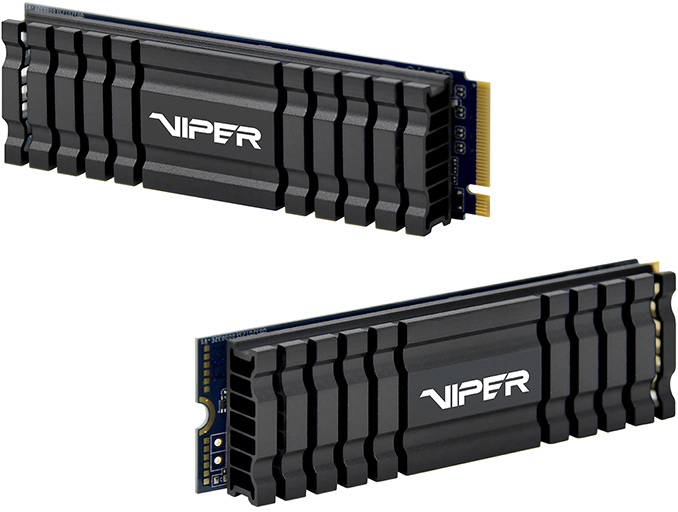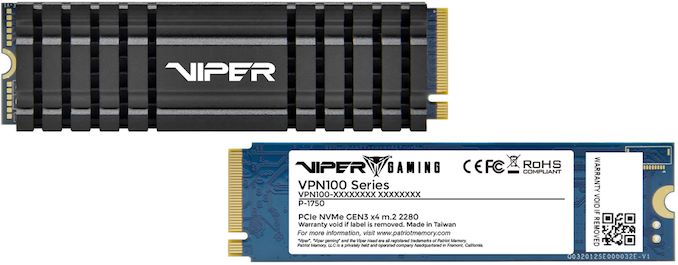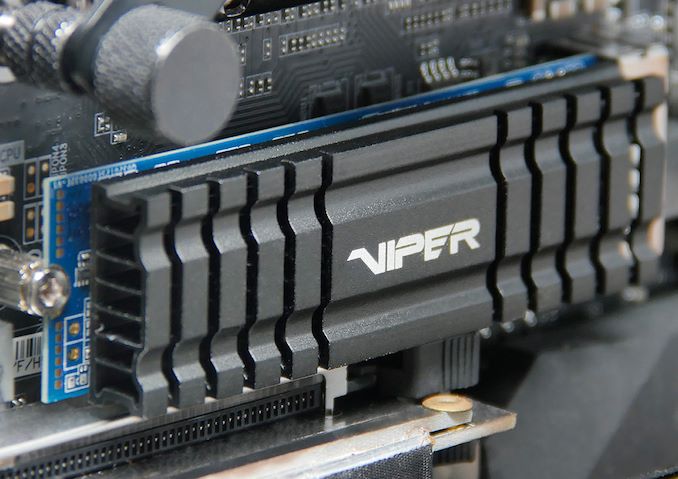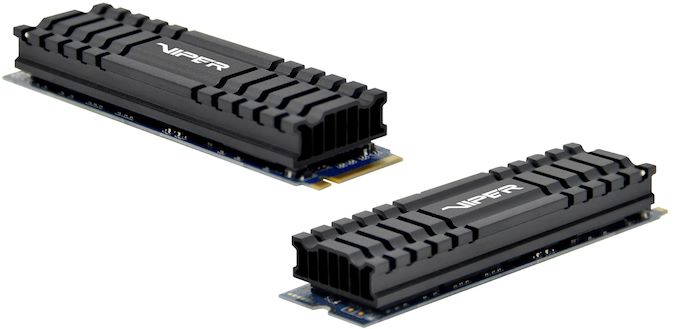Patriot Launches Viper VPN100 SSDs: Up to 2TB, Massive Heatsink
by Anton Shilov on March 29, 2019 5:30 PM EST- Posted in
- SSDs
- Storage
- Patriot
- Phison
- Viper
- 3D TLC
- PS5012-E12
- Viper VPN100

Patriot this week started sales of its top-of-the-range VPN100-series SSDs. Prototypes of these drives based on the Phison PS5012-E12 controller were demonstrated at CES 2018, but it took the company and its partner quite some time to finalize them. The undertaken efforts paid quite well: the Viper VPN100 promises to be one of the fastest SSDs on the market. To ensure that the drive performs consistently, Patriot equipped it with a large heatsink and an external thermal sensor.
Based on the Phison PS5012-E12 controller, the Patriot Viper VPN100 drives carry 256 GB, 512 GB, 1 TB, or 2 TB of usable 3D TLC NAND flash onboard along with DRAM cache. Being aimed at high-end PCs, the drives feature an M.2-2280 form-factor along with a PCIe 3.1 x4 interface. Given capabilities of the controller, the Viper VPN100 SSDs are NVMe 1.3 compatible, feature a robust LDPC-based ECC engine, SLC caching, and other features that customers come to expect from modern drives.
From performance point of view, the Viper VPN100-series products look quite impressive. The fastest 1 TB model offers sequential read speeds up to 3450 MB/s as well as sequential write speeds of up to 3000 MB/s. As for random read/write performance, we are dealing with an SSD capable of up to 600K read/write IOPS.
| Patriot Viper VPN100 SSDs Specifications | ||||
| Capacity | 256 GB VPN100-256GM28H |
512 GB VPN100-512GM28H |
1 TB VPN100-1TBM28H |
2 TB VPN100-2TBM28H |
| Controller | Phison PS5012-E12 | |||
| NAND Flash | Toshiba 64-layer BiCS3 3D TLC (?) | |||
| Interface | PCIe 3.1 x4 | |||
| Form-Factor | M.2-2280 | |||
| Sequential Read | 3 GB/s | 3.1 GB/s | 3.45 GB/s | 3.1 GB/s |
| Sequential Write | 1 GB/s | 2.2 GB/s | 3 GB/s | 3 GB/s |
| Random Read IOPS | 250,000 | 300,000 | 600,000 | 500,000 |
| Random Write IOPS | 100,000 | 100,000 | 600,000 | 500,000 |
| Idle Power Consumption | < 900 mW (?) | |||
| PCIe L1.2 Idle | < 2 mW (?) | |||
| Pseudo-SLC Caching | Yes | |||
| DRAM Buffer | 512 MB | |||
| TCG Opal Encryption | ? | |||
| Warranty | 3 years | |||
| MSRP at Launch | $79.99 | $137.99 | $244.99 | $499.99 |
| Retail Price at Launch | $59.99 | $94.99 | $199.99 | ? |
To ensure consistent performance even under high loads that might get the SSD controller very hot, Patriot equipped its Viper VPN100 drives with a large aluminum heatsink featuring six rather thick fins. The radiator will naturally prevent these SSDs from being installed into high-performance laptops, but this is a tradeoff that the manufacturer decided to take. Furthermore, the SSDs feature an external power sensor (in addition to the one integrated into the controller) to better monitor temperatures of the device. It was unclear if the heatsink would block a GPU if placed in the M.2 slot above a PCIe slot.
All Patriot Viper VPN100-series drives are backed by a three-year warranty. The Viper VPN100 256 GB carries an MSRP of $79.99, the 512 GB version features a recommended price of $137.99, the 1 TB model costs $244.99, whereas the top-of-the-range 2 TB SKU is priced at $499.99. Meanwhile, retailers like Amazon and Newegg already offer the new SSDs with tangible discounts.
Related Reading:
- Patriot Readies Viper SSDs With Phison E12 And S12
- Patriot Demos Viper M.2 SSDs with Phison E12, Up to 2 TB
- Patriot Preps Budget-Priced & Phison-Based Scorch NVMe SSD For Q3
- The Patriot Hellfire M.2 480GB Review: Phison NVMe Tested
Source: Patriot













31 Comments
View All Comments
Santoval - Friday, March 29, 2019 - link
Is the DRAM cache really 512 MB in all capacities? If that's the case it is very weird. Isn't it customary to employ 1 GB of DRAM for each 1 TB of NAND?M@tt4.0 - Saturday, April 27, 2019 - link
https://docs.wixstatic.com/ugd/20c502_1b35fbb645d9...here it is: 1GB cache for the 1TB version
r3loaded - Friday, March 29, 2019 - link
Looks awesome, just need the full Anandtech review to see whether it will decisively beat down a 970 Evo. At the very least, that massive heatsink will ensure you'd never have to think about thermal throttling.Billy Tallis - Saturday, March 30, 2019 - link
I have Gigabyte's Phison E12 drive on the testbed now. It has a similarly large heatsink, though it may not be quite as effective since GB threw in RGB LEDs while Patriot's heatsink looks like it's more serious about cooling ability.TomKansasCity - Saturday, March 30, 2019 - link
Flash your drive to 12.2 firmware ... it reduces temps. You can find the link the firmware tool on HardOCP forums. Do a search for Phison E12 controller.MDD1963 - Saturday, March 30, 2019 - link
Thank God we finally get a heatsink to help dissipate that horrendous 4-5W of peak power!UpSpin - Sunday, March 31, 2019 - link
You surely meant 11W of peak power: https://www.anandtech.com/show/13955/the-silicon-p...Considering the small space of the packages, yep, that definitely needs a heatsink, just as every CPU or SoC with such a power draw needs some kind of heatsink at the very least.
Billy Tallis - Sunday, March 31, 2019 - link
That 10.73W is merely what the drive claims its peak power consumption to be. In practice, the most I've measured from a consumer M.2 drive is about 6W.Opencg - Monday, April 1, 2019 - link
at what polling rate?Billy Tallis - Tuesday, April 2, 2019 - link
For what it's worth, my Quarch power meter internally samples at 4µs intervals but is usually configured to average in batches of 32k samples to reduce the volume of data. But even with ~1/8th second averaging, that's still quite a bit quicker than the seconds or minutes it takes NVMe SSDs to reach thermal throttling temperatures when subjected to unrealistic torture tests. Any power spikes in excess of the <6W sustained that I've measured were far too short-lived to have relevance to cooling needs.(And an M.2 drive that actually does exceed 10W is pretty likely to run into problematic voltage drop in the real world, since it's being fed at 3.3V nominal, and 3+A is a lot to push over a handful of pins on an M.2 connector. This is generally much more likely to cause trouble than overheating.)